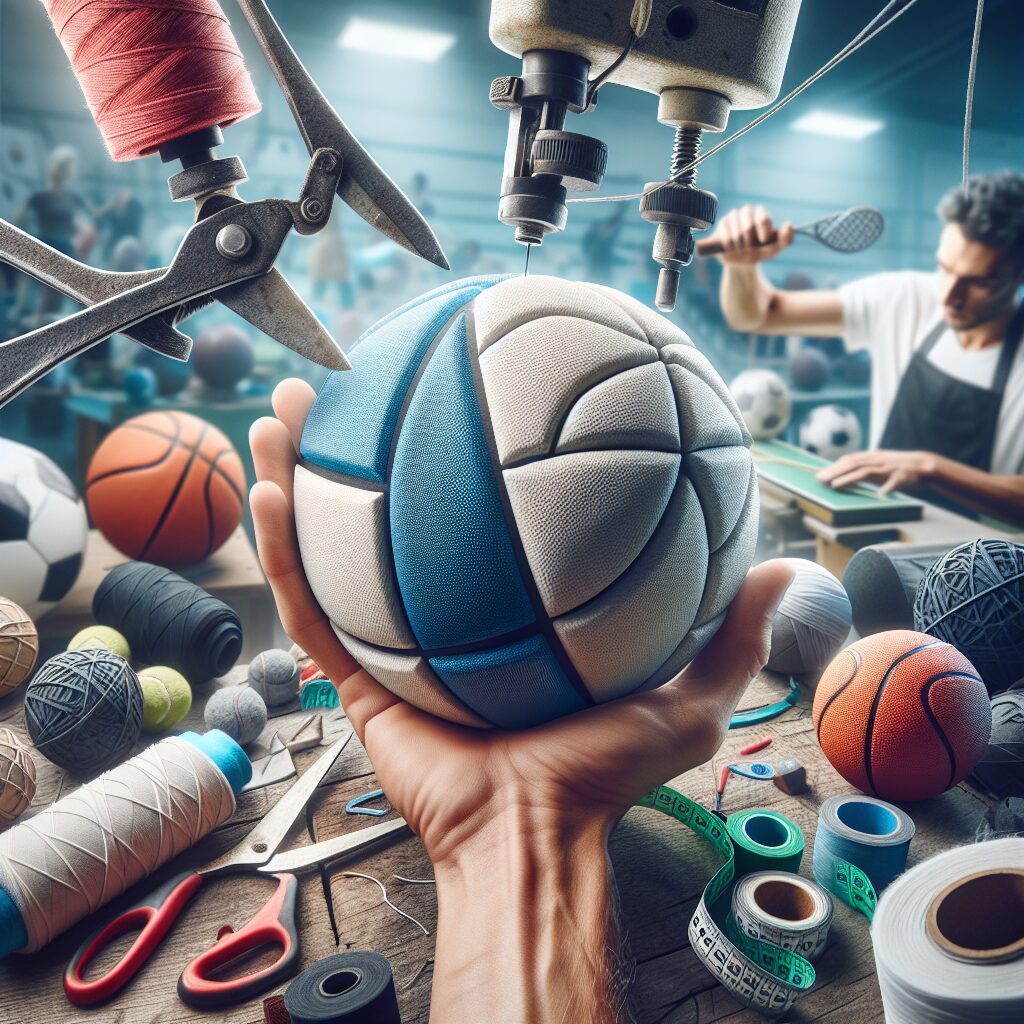Sustainability in sports has become a prominent topic in recent years, as the impact of various activities and processes on the environment has been widely discussed. One specific aspect of this conversation is the production of sports equipment, particularly balls. From soccer to basketball, the manufacturing processes involved in creating these essential sports tools have significant environmental consequences. Understanding the environmental impact of ball production can help us make more informed choices and promote sustainability in sports.
The production of sports balls involves various materials and processes, each with its own unique impact on the environment. For instance, the manufacturing of rubber for balls often involves deforestation, water pollution, and air emissions. Additionally, the synthetic materials used in the creation of balls, such as polyurethane or PVC, are derived from fossil fuels, contributing to carbon emissions and climate change. These factors highlight the need for sustainable alternatives that can reduce the environmental footprint of ball production.
In the following sections, we will delve deeper into the specific impacts of ball production on the environment, exploring the various stages involved in the manufacturing process. By understanding the key takeaways of this article, we can gain insight into the possible solutions and innovations that can help mitigate the negative environmental impact of sports equipment production. Let’s explore the environmental consequences of ball production and discover the potential for sustainable practices within the sports industry.
Key Takeaways
1. The production of sporting goods, specifically balls, has a significant environmental impact due to the extraction, processing, and transportation of raw materials, as well as the energy consumption and waste generated during manufacturing.
2. Several sports brands and organizations have recognized the importance of sustainability in ball production and have implemented measures to reduce their environmental footprint, such as using recycled and eco-friendly materials, optimizing energy and water use, and minimizing waste.
3. Innovative solutions, including the development of bio-based materials and environmentally friendly adhesives, have shown promising results in reducing the carbon emissions associated with ball production and creating a more sustainable industry.
4. The adoption of circular economy principles plays a crucial role in minimizing the environmental impact of ball production. Initiatives like recycling programs, reusing materials, and refurbishing or repurposing old balls help extend the lifespan of products and reduce waste.
5. Consumers have an essential role in driving sustainability in sports by making informed choices and supporting brands that prioritize eco-friendly practices. Educating consumers about the environmental implications of their purchasing decisions can lead to positive change and encourage greater accountability in the industry.
What is the Impact of Ball Production on Sustainability in Sports?
The Environmental Impact
Ball production in sports has a significant environmental impact, primarily due to the materials used and the manufacturing processes involved. Synthetic balls, commonly made from materials such as rubber, polyurethane, or PVC, require the extraction of natural resources and the use of energy-intensive manufacturing techniques. This results in carbon emissions, water pollution, and the depletion of non-renewable resources.
Furthermore, the disposal of used and worn-out balls can contribute to waste pollution. Many balls end up in landfills, where they take years to decompose due to their synthetic nature. Identifying sustainable alternatives in ball production is crucial to mitigate these environmental impacts.
Social and Ethical Considerations
In addition to the environmental impact, ball production also raises social and ethical concerns. The manufacturing process often involves human labor, which may be subject to poor working conditions, low wages, and even exploitative practices. Ensuring fair and ethical treatment of workers throughout the supply chain is essential for sustainable ball production in sports.
Moreover, the carbon footprint associated with transporting balls globally can also affect sustainability. The long-distance shipping of balls from manufacturing facilities to distribution centers and sports retailers contributes to greenhouse gas emissions. Promoting local production or exploring more sustainable transportation options can help address these issues.
Innovations and Solutions
The sports industry has been actively seeking sustainable solutions for ball production to minimize its environmental impact. One approach is the use of eco-friendly materials in ball manufacturing, such as recycled or biodegradable materials. By utilizing recycled rubber or natural alternatives like cork, manufacturers can reduce reliance on non-renewable resources and mitigate pollution from production and disposal.
Innovations in manufacturing processes, such as adopting energy-efficient technologies or reducing water consumption, also play a crucial role in sustainable ball production. Embracing circular economy principles, wherein the materials used in ball production can be recycled or repurposed, can further enhance sustainability.
The Role of Sports Brands and Associations
Sports brands and associations have a significant impact on sustainability in ball production. They can drive change by adopting strict environmental and ethical standards for their suppliers. By partnering with manufacturers committed to sustainable practices, brands can ensure that the balls they produce meet specific sustainability criteria.
Moreover, sports associations and governing bodies play a crucial role in promoting sustainable practices across the industry. They can raise awareness, develop guidelines for sustainable ball production, and incentivize both manufacturers and consumers to prioritize sustainability in sports.
Guidelines for Sustainable Ball Production:
- How can manufacturers reduce carbon emissions in the production process?
- What are some eco-friendly materials that can be used in ball production?
- What measures can sports brands take to ensure ethical treatment of workers in the supply chain?
- How can transportation-related carbon emissions be minimized in the distribution of balls?
- What strategies can be employed to promote local production of sports balls?
- How can the circular economy concept be applied to ball production?
- What role can sports associations play in encouraging sustainable practices?
Frequently Asked Questions
What is sustainability in sports and why is it important?
Sustainability in sports refers to the practice of minimizing the environmental impact of various sports-related activities and promoting responsible consumption and production. It is important because it helps to preserve natural resources, reduce carbon emissions, and create a healthier environment for athletes, fans, and the surrounding communities.
How does ball production impact sustainability in sports?
Ball production can have a significant impact on sustainability in sports due to the use of resources, such as raw materials and energy, as well as the generation of waste and carbon emissions during the manufacturing process. Therefore, adopting sustainable measures in ball production is crucial to ensure the overall sustainability of the sports industry.
What are some sustainable practices in ball production?
Some sustainable practices in ball production include using eco-friendly materials, such as recycled or organic materials, minimizing water usage, reducing energy consumption through efficient manufacturing processes, implementing recycling and waste management systems, and supporting fair labor practices throughout the supply chain.
Are sustainable balls as durable and high-quality as traditional balls?
Yes, sustainable balls can be just as durable and high-quality as traditional balls. With advancements in technology and materials, manufacturers have been able to create sustainable balls that meet the same performance standards while minimizing environmental impact. These balls undergo rigorous testing to ensure they perform well on the field while being eco-friendly.
Do sustainable balls cost more than traditional balls?
In some cases, sustainable balls may have a slightly higher initial cost due to the use of eco-friendly materials and production methods. However, in the long run, they can help save costs by reducing the environmental footprint and potentially attracting environmentally conscious consumers. Additionally, as sustainable practices become more widespread, economies of scale may reduce the cost difference between sustainable and traditional balls.
How can sports organizations promote sustainability in ball production?
Sports organizations can promote sustainability in ball production by collaborating with manufacturers to set sustainability criteria for ball production, encouraging the use of eco-friendly materials and production practices through certification programs, supporting research and development of sustainable alternatives, and raising awareness among athletes, fans, and stakeholders about the importance of sustainable ball production.
Can individual athletes contribute to sustainability in ball production?
Absolutely! Individual athletes can contribute to sustainability in ball production by choosing to use sustainable balls themselves and encouraging their sponsors or team management to prioritize sustainability in their equipment choices. Athletes can also engage in environmental initiatives, such as promoting recycling and responsible consumption, as role models for their fans and the wider sports community.
What impact does sustainable ball production have on local communities?
Sustainable ball production can have a positive impact on local communities by promoting fair labor practices, providing job opportunities, and supporting the local economy. Additionally, sustainable production methods can reduce pollution and waste, creating a healthier living environment for communities surrounding ball production facilities.
Are there any regulations or certifications related to sustainable ball production?
Yes, several organizations have developed certifications and standards related to sustainable ball production. For example, the Forest Stewardship Council (FSC) certifies sustainable wood used in ball production, and the Global Organic Textile Standard (GOTS) certifies sustainable organic materials. These certifications help consumers identify products that meet strict sustainability criteria.
How can consumers support sustainability in ball production?
Consumers can support sustainability in ball production by choosing to purchase and use sustainable balls, actively seeking out products with recognized certifications, and educating themselves about the environmental impact of ball production. Additionally, consumers can advocate for sustainability within sports by demanding transparency from brands and organizations regarding their production practices and supporting initiatives that prioritize sustainability.
Final Thoughts: Sustainability in Sports: The Impact of Ball Production
Sustainability in sports, especially in the production of balls, plays a crucial role in minimizing the industry’s environmental footprint. By adopting sustainable practices, from using eco-friendly materials to reducing waste and carbon emissions, sports organizations can make a significant positive impact on the planet. Moreover, sustainable ball production not only benefits the environment but also contributes to the overall health and well-being of athletes, fans, and communities involved in the world of sports. It is essential for all stakeholders, including athletes, manufacturers, and consumers, to actively support and prioritize sustainability, ensuring the long-term viability of sports in harmony with nature.
The future of sports lies in sustainable practices, and it is heartening to see the increasing efforts and initiatives towards greener ball production. As the demand for sustainable products continues to rise and technology progresses, we can anticipate even greater advancements in sustainable ball production. By choosing sustainable balls, supporting certified products, and advocating for responsible production, each of us can be a catalyst for positive change in the sports industry and contribute to a better, more sustainable world.




